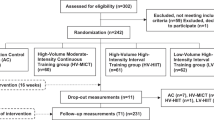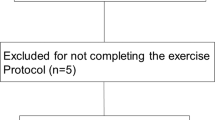Abstract
Purpose
Cardiovascular safety of aerobic exercise with blood flow restriction (BFR) has been little studied in clinical populations. This study investigated the effects of different levels of BFR on cardiac autonomic response during and after walking tasks in pre-hypertensive men.
Methods
Twelve pre-hypertensive men performed three randomly assigned experimental sessions: (1) 20 min of walking at 40% of peak running velocity (Vpeak) without BFR (CON); (2) 20 min of walking at 40% of Vpeak with BFR sets at 40% of the maximum cuff pressure that fully interrupted blood flow (BFR40); and (3) 20 min of walking at 40% of Vpeak with BFR sets at 80% of the maximum cuff pressure that fully interrupted blood flow (BFR80). The HR and HRV measurements were taken at rest, during exercise, and during the recovery period after constant load sessions.
Results
Heart rate was higher throughout the BFR80 session when compared to the CON condition (p < 0.05). The time constant of heart rate recovery was higher in both BFR80 (73.2 ± 28.8 s) and BFR40 (49.8 ± 16.1 s) compared to CON (24.3 ± 7.8 s; p < 0.01). In addition, the cardiac vagal modulation during recovery was lower in the BFR80 than CON (p < 0.05), but there was no significant difference between BFR40 and CON or between BFR80 and BFR40 (p > 0.05).
Conclusions
Restricting blood flow imposes additional cardiovascular stress during and after exercise in pre-hypertensive men, with apparently greater stress as the level of BFR increases.




Similar content being viewed by others
Abbreviations
- τ :
-
Time constant of heart rate decay
- BFR:
-
Blood flow restriction
- BFR40:
-
Walking at 40% of peak running velocity with 40% blood flow restriction
- BFR80:
-
Walking at 40% of peak running velocity with 80% blood flow restriction
- CON:
-
Walking at 40% of peak running velocity
- HF:
-
High-frequency power
- HR:
-
Heart rate
- HRV:
-
Heart rate variability
- LF:
-
Low-frequency power
- RMSSD:
-
Root mean square of successive differences between adjacent normal R–R intervals
- RMSSD60s :
-
Root mean square of successive differences between adjacent normal R–R intervals on subsequent 60 s non-overlapped segments
- RRi:
-
R–R intervals
- SDNN:
-
Standard deviation of consecutive R–R intervals
- Vpeak :
-
Peak running velocity
References
Abe T, Sakamaki M, Fujita S et al (2010) Effects of low-intensity walk training with restricted leg blood flow on muscle strength and aerobic capacity in older adults. J Geriatr Phys Ther 33:34–40
Ozaki H, Sakamaki M, Yasuda T et al (2011) Increases in thigh muscle volume and strength by walk training with leg blood flow reduction in older participants. J Gerontol A Biol Sci Med Sci 66:257–263. https://doi.org/10.1093/gerona/glq182
Kim D, Singh H, Loenneke JP et al (2016) Comparative effects of vigorous intensity and low-intensity blood flow restricted cycle training and detraining on muscle mass, strength, and aerobic capacity. J Strength Cond Res 30:1453–1461. https://doi.org/10.1519/JSC.0000000000001218
Ferreira-Junior A, de Araújo AC, Chimin P et al (2019) Effect of walk training with blood flow restriction on oxygen uptake kinetics, maximum oxygen uptake and muscle strength in middle-aged adults. Med Sport 72:616–627. https://doi.org/10.23736/S0025-7826.19.03402-1
Abe T, Kearns CF, Sato Y (1985) Muscle size and strength are increased following walk training with restricted venous blood flow from the leg muscle, Kaatsu-walk training. J Appl Physiol 100:1460–1466. https://doi.org/10.1152/japplphysiol.01267.2005
Park S, Kim JK, Choi HM et al (2010) Increase in maximal oxygen uptake following 2-week walk training with blood flow occlusion in athletes. Eur J Appl Physiol 109:591–600. https://doi.org/10.1007/s00421-010-1377-y
Ferreira-Junior A, Schamne JC, Altimari LR et al (2019) Effect of walk training combined with blood flow restriction on resting heart rate variability and resting blood pressure in middle-aged men. Motriz 25:1–6. https://doi.org/10.1590/S1980-6574201900020005
Ferreira-Junior A, Schamne JC, Perandini LAB et al (2019) Effects of walking training with restricted blood flow on HR and HRV kinetics and HRV recovery. Int J Sports Med 40:585–591. https://doi.org/10.1055/a-0942-7479
May AK, Brandner CR, Warmington SA (2017) Hemodynamic responses are reduced with aerobic compared with resistance blood flow restriction exercise. Physiol Rep 5:1–10. https://doi.org/10.14814/phy2.13142
Thomas HJ, Scott BR, Peiffer JJ (2018) Acute physiological responses to low-intensity blood flow restriction cycling. J Sci Med Sport 21:969–974. https://doi.org/10.1016/j.jsams.2018.01.013
Silva JCG, Pereira Neto EA, Pfeiffer PAS et al (2019) Acute and chronic responses of aerobic exercise with blood flow restriction: a systematic review. Front Physiol 4:1239. https://doi.org/10.3389/fphys.2019.01239
Staunton CA, May AK, Brandner CR et al (2015) Haemodynamics of aerobic and resistance blood flow restriction exercise in young and older adults. Eur J Appl Physiol 115:2293–2302. https://doi.org/10.1007/s00421-015-3213-x
Renzi CP, Tanaka H, Sugawara J (2010) Effects of leg blood flow restriction during walking on cardiovascular function. Med Sci Sports Exerc 42:726–732. https://doi.org/10.1249/MSS.0b013e3181bdb454
Fisher JP, Adlan AM, Shantsila A (2013) Muscle metaboreflex and autonomic regulation of heart rate in humans. J Physiol 591:3777–3788. https://doi.org/10.1113/jphysiol.2013.254722
Fisher JP (2013) Autonomic control of the heart during exercise in humans: role of skeletal muscle afferents. Exp Physiol 99:300–305. https://doi.org/10.1113/expphysiol.2013.074377
Spranger MD, Krishnan AC, Levy PD et al (2015) Blood flow restriction training and the exercise pressor reflex: a call for concern. Am J Physiol Heart Circ Physiol 309:H1440–H1452. https://doi.org/10.1152/ajpheart.00208.2015
Peçanha T, Bartels R, Brito LC et al (2017) Methods of assessment of the post-exercise cardiac autonomic recovery: a methodological review. Int J Cardiol 15:795–802. https://doi.org/10.1016/j.ijcard.2016.10.057
Ferreira MLV, Sardeli AV, De-Souza GV et al (2017) Cardiac autonomic and haemodynamic recovery after a single session of aerobic exercise with and without blood flow restriction in older adults. J Sports Sci Med 35:2412–2420. https://doi.org/10.1080/02640414.2016.1271139
Michael S, Jay O, Graham KS et al (2017) Higher exercise intensity delays postexercise recovery of impedance-derived cardiac sympathetic activity. Appl Physiol Nutr Metab 42:834–840. https://doi.org/10.1139/apnm-2017-0049
Tsuji H, Larson MG, Venditti FJ Jr et al (1996) Impact of reduced heart rate variability on risk for cardiac events. The Framingham HeartStudy. Circulation 94:2850–2855. https://doi.org/10.1161/01.cir.94.11.2850
Schamne JC, Ferreira-Junior A, Araújo AC et al (2019) Cardiac autonomic responses during and after a single session of aerobic exercise with and without blood flow restriction. Motriz 25:1–7. https://doi.org/10.1590/S1980-6574201900030015
Cristina-Oliveira M, Meireles K, Spranger MD et al (2020) Clinical safety of blood flow-restricted training? A comprehensive review of altered muscle metaboreflex in cardiovascular disease during ischemic exercise. Am J Physiol Heart Circ Physiol 318:H90–H109. https://doi.org/10.1152/ajpheart.00468.2019
Greaney JL, Matthews EL, Boggs ME et al (2014) Exaggerated exercise pressor reflex in adults with moderately elevated systolic blood pressure: role of purinergic receptors. Am J Physiol Heart Circ Physiol 306:H132–H141. https://doi.org/10.1152/ajpheart.00575.2013
Thompson PD, Franklin BA, Balady GJ et al (2007) Exercise and acute cardiovascular events placing the risks into perspective: a scientific statement from the American Heart Association Council on Nutrition, Physical Activity, and Metabolism and the Council on Clinical Cardiology. Circulation 115:2358–2368. https://doi.org/10.1161/CIRCULATIONAHA.107.181485
Chobanian AV, Bakris GL, Black HR et al (2003) Seventh report of the Joint National Committee on Prevention, Detection, Evaluation, and Treatment of High Blood Pressure. Hypertension 42:1206–1252. https://doi.org/10.1161/01.HYP.0000107251.49515.c2
Pickering TG, Hall JE, Appel LJ et al (2005) Recommendations for blood pressure measurement in humans: an AHA scientific statement from the Council on High Blood Pressure Research Professional and Public Education Subcommittee. J Clin Hypertens (Greenwich) 7:102–109. https://doi.org/10.1111/j.1524-6175.2005.04377.x
Javorka M, Zila I, Balhárek T et al (2003) On- and off-responses of heart rate to exercise – relations to heart rate variability. Clin Physiol Funct Imaging 23:1–8. https://doi.org/10.1046/j.1475-097x.2003.00460.x
Task-Force (1996) Heart rate variability. Standards of measurement, physiological interpretation, and clinical use. Circulation 93:1043–1065
Takano H, Morita T, Iida H et al (2005) Hemodynamic and hormonal responses to a short-term low-intensity resistance exercise with the reduction of muscle blood flow. Eur J Appl Physiol 95:65–73. https://doi.org/10.1007/s00421-005-1389-1
Silva JCG, Domingos-Gomes JR, Freitas EDS et al (2019) Physiological and Perceptual Responses to Aerobic Exercise With and Without Blood Flow Restriction. J Strength Cond Res. 2019 (In Press). https://doi.org/https://doi.org/10.1519/JSC.0000000000003178
Pierpont GL, Stolpman DR, Gornick CC (2000) Heart rate recovery post-exercise as an index of parasympathetic activity. J Auton Nerv Syst 80:169–174. https://doi.org/10.1016/s0165-1838(00)00090-4
Kannankeril PJ, Le FK, Kadish AH et al (2004) Parasympathetic effects on heart rate recovery after exercise. J Investig Med 52:394–401. https://doi.org/10.1136/jim-52-06-34
Kim KA, Stebbins CL, Choi HM et al (2015) Mechanisms Underlying exaggerated metaboreflex activation in prehypertensive men. Med Sci Sports Exerc 47:1605–1612. https://doi.org/10.1249/MSS.0000000000000573
Sausen MT, Delaney EP, Stillabower ME et al (2009) Enhanced metaboreflex sensitivity in hypertensive humans. Eur J Appl Physiol 105:351–356. https://doi.org/10.1007/s00421-008-0910-8
Peçanha T, de Brito LC, Fecchio RY et al (2016) Metaboreflex activation delays heart rate recovery after aerobic exercise in never-treated hypertensive men. J Physiol 1:6211–6223. https://doi.org/10.1113/JP272851
Funding
Not applicable.
Author information
Authors and Affiliations
Corresponding author
Ethics declarations
Conflict of interest
The authors declare no conflict of interest.
Ethical approval
The study was approved by the Local Ethics Committee and performed in accordance with the recommendations from the Declaration of Helsinki.
Informed consent
All participants signed an informed consent statement before beginning the study.
Additional information
Publisher's Note
Springer Nature remains neutral with regard to jurisdictional claims in published maps and institutional affiliations.
Rights and permissions
About this article
Cite this article
Schamne, J.C., Motin, C., Sochodolak, R.C. et al. Cardiac autonomic response to aerobic exercise with different levels of blood flow restriction in pre-hypertensive men. Sport Sci Health 17, 375–382 (2021). https://doi.org/10.1007/s11332-020-00699-3
Received:
Accepted:
Published:
Issue Date:
DOI: https://doi.org/10.1007/s11332-020-00699-3




